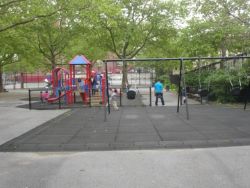Admiral Farragut Playground
Admiral Farragut Playground
“Damn the torpedoes! Full speed ahead!”
-Admiral David Glasgow Farragut (1801-1870)
Admiral David Glasgow Farragut was one of the great figures of the Civil War. His courageous naval victories during the bloody war established him as a national hero, and he eventually became America’s first admiral. Farragut was born on July 5, 1801, near Knoxville, Tennessee, and legend has it he entered the U.S. Navy as a midshipman at the age of nine. He was captured by the British during the War of 1812, but was released and later served in the Mediterranean Sea. Farragut demonstrated a clear talent for naval affairs, and he advanced rapidly through the ladder of command, attaining the rank of commander by 1840. He participated in the blockade of the Gulf of Mexico during the Mexican War (1846-48), and was promoted to captain after establishing the Mare Island Navy Yard at San Francisco in 1854.
Despite being born in the South, Farragut declared his loyalty to the Union when the Civil War broke out. In January 1862, he received command of the West Gulf Blockading Squadron, and was ordered to capture New Orleans. On April 18, 1862, the squadron began bombarding Confederate forts along the mouth of the Mississippi River, but after six days he had achieved little success. Impatient with the squadron’s lack of progress, Farragut led the fleet up the river, chugging along past the raking gunfire from the forts. Farther upriver, he defeated a Confederate flotilla, and on April 25, 1862, New Orleans surrendered. This was a crippling loss for the Confederacy, as it allowed the Union to blockade the Mississippi River, which served as the key shipping artery for the South.
Farragut was victorious in several other naval battles during the war, most notably at the Battle of Mobile Bay, Alabama, which some consider the definitive naval battle of the Civil War. Mobile Bay was a favorite port and hiding place for Confederate ships seeking to elude the Union’s naval blockade. At about 6 a.m. on August 5, 1864, Farragut ordered his fleet into the passage at the bay, where they came under fire from the two forts on guard. When told about torpedoes in the water, Farragut roared back, “Damn the torpedoes! Full speed ahead!” His fleet broke through, sank several Confederate ships, and bombarded the forts into submission. Thanks to this decisive victory, the Union was able to defeat the Confederacy, reaching peace in April 1865. In recognition of Farragut’s talents, Congress created for him the ranks of vice-admiral (1864) and admiral (1866).
Farragut spent much of his later life in New York City and New England. He died on August 14, 1870, in Portsmouth, New Hampshire. Unlike most military heroes, Farragut was not buried in the national cemetery at Arlington, Virginia. Instead, his wife requested that he be buried in a place that he loved: New York City. Admiral Farragut was laid to rest in the Bronx’s famous Woodlawn Cemetery. The president, vice-president, and the entire cabinet attended his funeral and trailed the procession to the grave. In 1880, sculptor Augustus Saint-Gaudens (1848-1907) and architect Stanford White (1853-1906) collaborated to create the Farragut Monument, located on the north end of Madison Square, near 26th Street, in Manhattan.
The City acquired this property in conjunction with the construction of the Cross-Bronx Expressway, and Admiral Farragut Playground was built in 1950. The playground contains play equipment, swings, benches, and a baseball diamond. Children use the park frequently, thanks to its location on Clinton Avenue next to the Farragut School, C.S. 44.
Check out your park's Vital Signs
Clean & Safe
Green & Resilient
Empowered & Engaged Users
Share your feedback or learn more about how this park is part of a
Vital Park System

